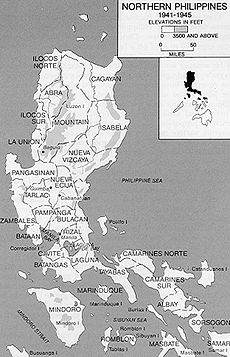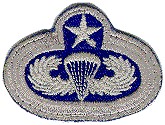11th Airborne Division (United States)
The 11th Airborne Division ( German 11th Airborne Division ), also "The Angels" was called, was an Airborne Division of the United States Army , which on February 25, 1943 in Camp Mackall under the command of Major General Joseph W. Swing was set up . During the Second World War, she made a major contribution to the liberation of the Philippine island of Luzon from Japanese occupation and was stationed in Japan after the war and later in Germany . It was disbanded in 1958 and replaced a few years later by the 11th Air Assault Division , which in turn was disbanded in 1965.
history
Second World War
The 11th US Airborne Division reached New Guinea on May 25, 1944 , after being embarked from San Francisco , where it trained until November 1944. The focus was on new tactics such as warfare in the jungle, but also on the core skills, so several jumps were made. On November 11, 1944, the division left New Guinea for the Philippines . It landed on November 18 of the same year amphibiously - not from the air - between Abuyog and Tarragona, 40 miles south of Tacloban , on the island of Leyte , and advanced inland. The Japanese supply route between Ormoc and Burauen , an important Japanese battle line, was conquered. The main task of the division was, on the one hand, to capture and secure all exits from the mountains into the valley of Leyte and, on the other hand, to secure the mountain exits in the western coast to support the attack of the 7th Infantry Division on Ormoc.

On December 6, 1944, the paratroopers of the US 11th Airborne Division fought Japanese paratroopers who had landed near the San Pablo runway. The Japanese units were wiped out within five days. In a series of battles, the Japanese resistance was broken in Leyte in late December. The strong enemy position on Rock Hill was overcome on December 18th. In January 1945, the division gathered new forces and prepared for a landing on Luzon . While other American troops attacked Manila from the north on January 31, 1945 , the 11th US Airborne Division landed amphibiously at Nasugbu, 60 miles south of Manila, and advanced from there to the Philippine capital.
The first jump of a unit of the division in World War II - that of the 511th Parachute Infantry Regiment on the Tagaytay ridge on February 3 - met with no resistance. The 511th regiment crossed the Paranaque River on February 5 and reached Manila. There the Japanese defended themselves again doggedly. On February 12, the division captured Nichols Field and flanked Fort McKinley from February 12 to 16, and took it on February 17. On February 23, more than 2,000 American and European prisoners of war held in Los Banos were freed by a combined air and sea attack. After Manila was liberated, the division broke through a strong ring of enemy positions around Lake Taal and Laguna de Bay and took Highway No. 1 located cities. In April, the US 11th Airborne Division and other units dug even smaller pockets of resistance in Batangas Province. On May 1st, all resistance in southern Luzon was broken.
The division's last operation was carried out on June 23, 1945, along with the advance of the 37th Infantry Division in northern Luzon. A newly formed special unit jumped off over the Camalaniugan airfield. After an immediate attack against the Japanese lying there, the division was able to catch up to the 37th Division on June 26 between Alcala and the Paret River. After the division trained in July 1945, it was flown to Honshū after the surrender of Japan on August 30 of the same year to be the first American unit to occupy the Atsugi airport near Tokyo and the port of Yokohama there in an airborne operation .
post war period
After completing the job in Japan, the division returned to Camp Campbell in Kentucky in 1949 as a training force . The division's last overseas deployment began in 1956 when it replaced the 5th US Infantry Division in West Germany (in the 7th US Army , VII Corps ) as part of the Gyroscope troop rotation. Like its predecessor, it was stationed in Augsburg ( Sheridan and Reese barracks ) and in the immediate vicinity at the Gersthofen-Gablingen airfield and in Munich and was organized according to the new Pentomic structure intended for nuclear warfare . During this time, she conducted the first parachute training courses for the newly established airborne troops of the Bundeswehr in Augsburg and trained the teaching staff at the airborne and air transport school . In mid-1958, the 11th US Airborne Division in Augsburg and Munich was replaced by the 24th US Infantry Division ; At the time of this changeover, the association was involved in the US intervention in Lebanon . The airborne elements of the 24th US Infantry Division were replaced by 1959.
In 1963, the 11th Air Assault Division (Test) , which took in many of the members of the 11th Airborne Division, was established at Fort Benning to test helicopter attack tactics. Its commander was Major General Harry WO Kinnard , who had already served as chief of staff in the 101st Airborne Division during World War II . With the dissolution of the 11th Air Assault Division (Test) in 1965, the history of the 11th US Airborne Division also ended. The concept of airmobile infantry was carried forward by the 1st Cavalry Division and today by the 101st Airborne Division.
Commanders
- Major General Joseph M. Swing (February 25, 1943 to February 1946)
- Brigadier General Frank Dorn (February 1946 to June 1946)
- Major General Joseph M. Swing (June 1946 to January 1948)
- Major General William M. Miley (January 24, 1948 to January 1950)
- Major General Lyman L. Lemnitzer (January 1950 to November 1951)
- Maj. Gen. Wayne C. Smith (November 1950 to January 1952)
- Major General Ridgely Gaither (February 1952 to March 1953)
- Maj. Gen. Wayne C. Smith (May 1953 to May 1955)
- Major General Derrill McDaniel (June 1955 to September 1956)
- Maj. Gen. Hugh P. Harris (October 1956 to April 1958)
- Major General Ralph Cooper (1958 to June 1958)
- Major General Harry WO Kinnard (1963-1965 (Commander, 11th Air Assault Division (Test) ))
literature
- EM Flanagan Jr .: The Angels: A History of the 11th Airborne Division. - Novato, CA, USA: Presidio Press, 1989 . - ISBN 0-89141-358-8
Web links
- thedropzone.com (English)
- ww2-airborne.us (English)
- Combat chronicle of the 11th Airborne Division in World War II (English)


